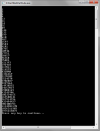How would you fix it if you wanted the entry point of your program to be NewbieChameleon? You would use the -e or --entry command line option for ld:
-eEntryPointLabel
--entry=EntryPointLabel
I use a makefile and used this for an example and 64bit O:
ld -o $(APP) $(APP).o -melf_i386 -eNewbieChameleon -dynamic-linker /lib/ld-linux.so.2


